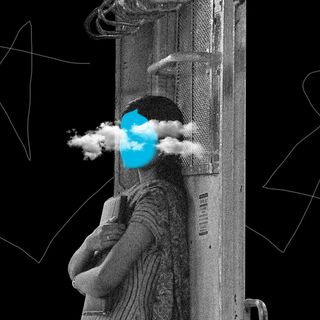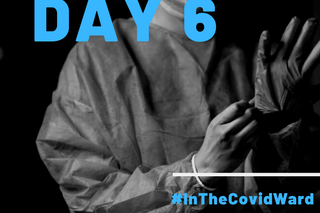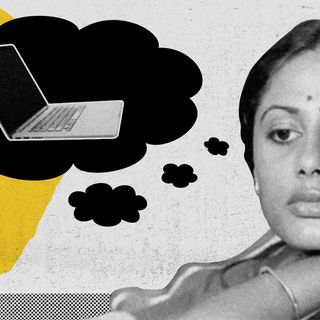
Doctor Diary, Day 6: “The First Day I Didn’t Have a Surgical Cap, So I Had to Use a Towel”
“We are over-extending, the doctor to patient ratio has long been outnumbered but we’re still working,” she says.

A 28-year-old anesthetist working in the OR of a government hospital in Mumbai shares the ups and downs of her days as a doctor amidst the Covid19 pandemic. This is the sixth installment of a daily diary she shares with The Swaddle.
Doctor Diary, Day 5: “It’s the First Day of Quarantine. I Kept My Promise of Minimal Covid19 Talk.”
*
I’ve just come out of a five-day quarantine. I’m back at my old government hospital, on OR duty. So I’m called in on a rotation basis, as and when we get cases.
My break was nice. One day, we had a girls’ night with the juniors, ordered pizza, talked until 2 a.m., rekindling old memories of our residency days. After four days, though, I was done. I went to my fiancé’s house — he has a dog, a golden retriever, so I got a nice lick-y welcome; it felt good. I was relieved to be back in a normal place with normal people. They cook, so I got to eat regular ghar ka khana. I had to leave the next morning, though. The hospital I was moving to told me I would be posted in the OR, as they had enough people in the I.C.U.
Initially, I wasn’t keen on the OR duty because all of my colleagues were working in the I.C.U. and I was the only junior in OR rotation. With seniors, it’s often difficult to connect. You have to coordinate with people you don’t socialize with. But here, people are already handling a lot of problems so I didn’t want to become an extra one.
Morning: Waking up late I had a tough month before this. I’m now at my old apartment that is closer to the new hospital I’m working at. My morning goes in cleaning, cooking, doing the bartan. Today, I didn’t want to cook because I anticipated that I’ll get a call to come in around noon/1 p.m.
Technically, I’m on call 24/7. Even though it’s a rotation, and I get called in every other day, there’s always this thing at the back of my mind that I can be called in next. My sleep is slightly disturbed because of it. Back at the other hospital, when I was on I.C.U. duty, I knew my shifts. If I worked for six hours one day, I knew exactly when I’d be working next. Here, I’m never really sure when it could be my turn. But I’m getting used to it — over time, I’ll start figuring out a pattern.
Afternoon: Going to work I got a call around 1 p.m. to come in; they wanted to take a patient to the OR for a cesarean section.
I remember the first one I did after being back at this hospital was early Sunday morning, when I got a call around 2 a.m. to come in. After going through it, I remember feeling good about it. There’s a baby, the patient isn’t high-risk — you feel good about it. Most patients are asymptomatic or mildly asymptomatic. The mothers are doing fine, they’re stable.
Most of the pregnant patients come referred from other centers. Most centers don’t accept Covid19 patients who go in for other treatments. First and foremost, they do the test. For pregnant patients, even a mild cough is enough to warrant a test, as they are considered high-risk.
Ours is one of the premier antenatal centers in the area, and we’re a Covid19 center. Honestly, it’s quite a relief to be in an environment where patients are doing well. For example, when I gave my first OR patient — a pregnant woman — regional anesthesia, there was no real scare that she’d need ventilation or have to go into the I.C.U. Today, I went in after a gap of two days. It went smoothly.
The first thing I have to do when I get in is go to the dean’s office and collect my PPE. At first, I was definitely anxious. The first day I didn’t have a surgical cap, so I had to use a towel as a turban which made me blind and deaf. The second time around I figured it out and made sure I asked for proper PPE and got it beforehand. The PPE itself is decent. The only thing is — if you run short, sometimes you have to reuse face shields. I’ve used mine twice.
However, donning and doffing the PPE is not the same as it was in the old hospital. There were clearly demarcated areas there. Here, there’s a lot of intermixing between Covid19 and clean areas, so people with PPE are in the same room with people not wearing PPE. Maybe people don’t want to take the extra precautions any longer. Maybe they’re less afraid now. I’m not one of them yet.
After getting the PPE, I went to the OR floor, did a pre-OP assessment, got consent from the patient and explained the procedure to her. We decided to give her a spinal anesthesia — we inject a drug in her spine, it’s like a prick in the back that numbs her from chest downwards. The surgery went on for 1.5 hours. My seniors say it used to take a lot longer at the beginning — about three hours — but now they’ve gotten used to the PPE.
It was my first procedure that I did wearing PPE — I was apprehensive because of the excess fogging, but we managed. Then, I shifted my patient, collected another set of PPE for the next case, and went home.
Evening: Relaxing I did some wedding shopping. I don’t think I’ll have the time to do it physically. Then, a friend of mine from college wanted to do an interview with me for a course he was doing. I kept bursting into laughs but we managed to pull through.
Then, we made bhel for dinner. I don’t think I’ll get a call until tomorrow evening.
I’m definitely much more relaxed. Being answerable to relatives is what drove me nuts at the other hospital. That’s what really took an emotional toll. Here, it’s not so bad. The patient’s doing well, you’re helping knock the patient out for surgery because it’s necessary; it’s not a life and death kind of situation. It’s not as chaotic.
Now, it’s also safer for us. We also have to look at what’s safe for us.
I will say — we handle a lot but we can’t handle everybody. Now with Covid19 going on, a lot of private hospitals have closed their doors to patients until they’re willing to pay more than what is normally expected. It may be justified because they shell out more for PPEs every single time they do a surgery, for the ward boy, the doctors, the nurses. They pay from their own pockets; I’m not sure if the government helps them.
Anyway, they charge humongously, so patients who would normally go to private — to seek antenatal care, for example — can’t afford to anymore. The same patients don’t feel comfortable coming to government set-ups because they think it’s filthy. But because of the numbers we handle at the government hospital, we aren’t able to give the premier care these patients might be expecting. This is happening because private has shut its doors, not because we’re not doing enough. We are over-extending, the doctor to patient ratio has long been outnumbered but we’re still working.
As told to Rajvi Desai.
Doctor Diary, Day 7: “In the Middle of the Sampling, I Had a Blackout.”
Related


Why We Want to Be Idle When We’re Busy, and Busy When We’re Idle
